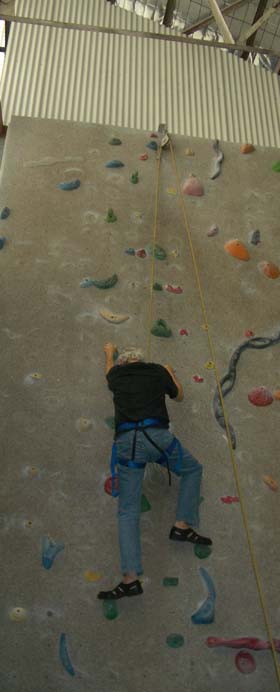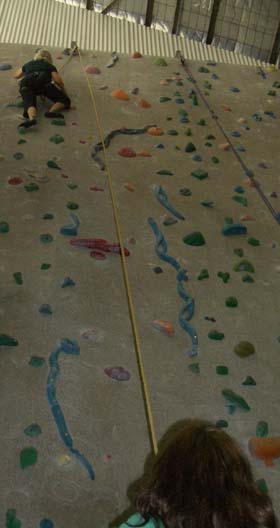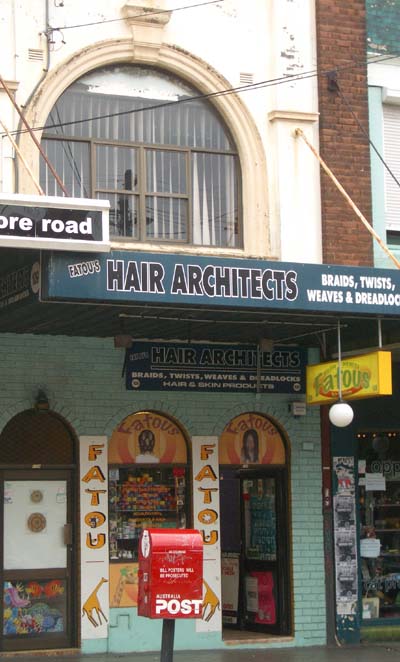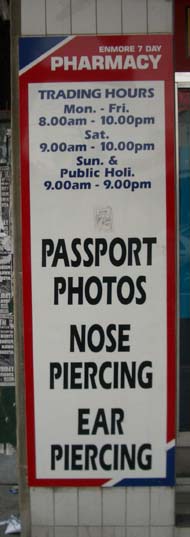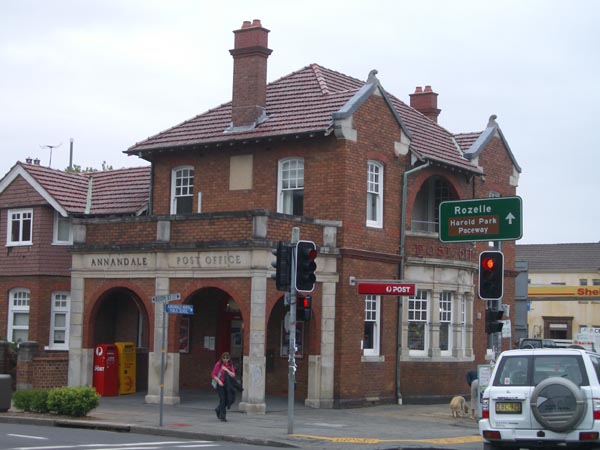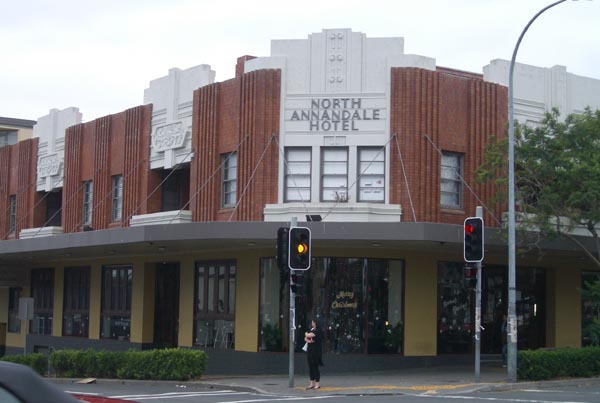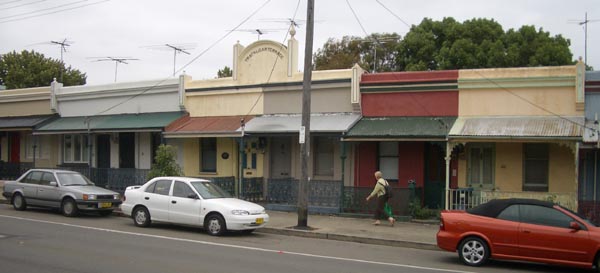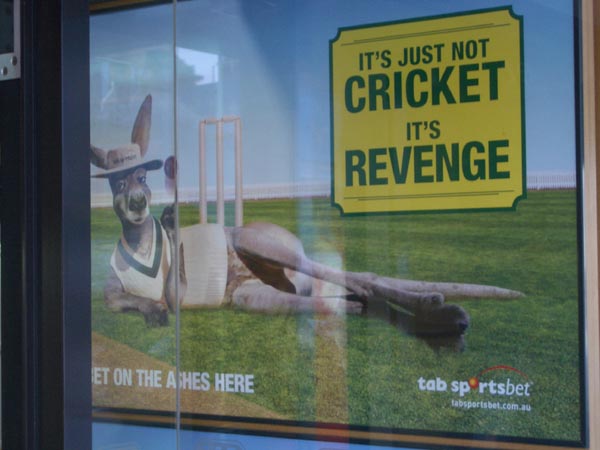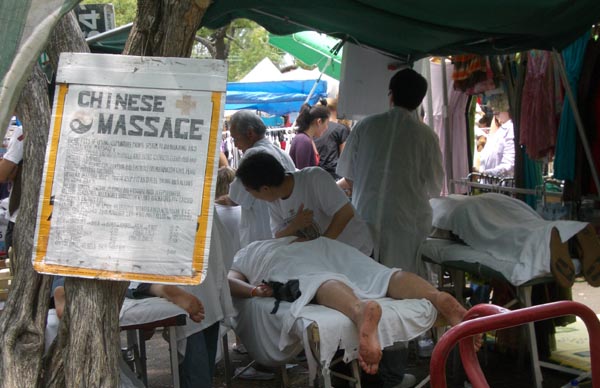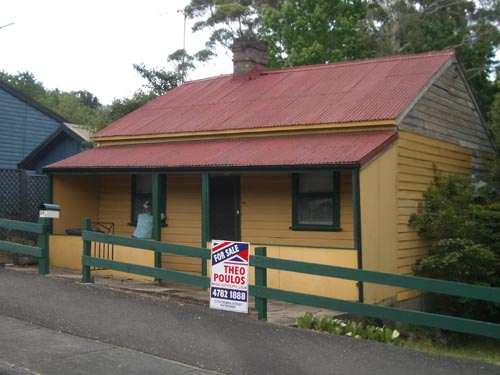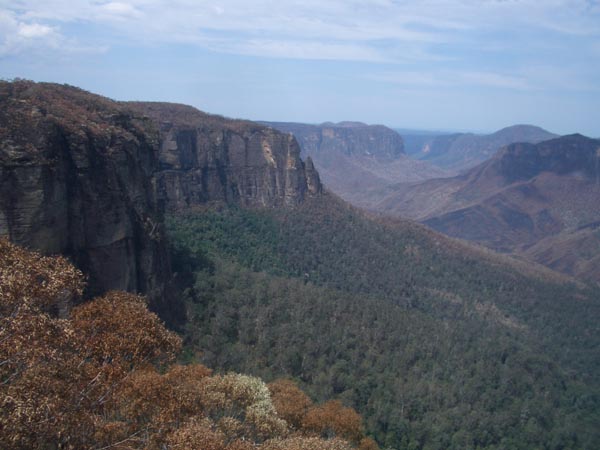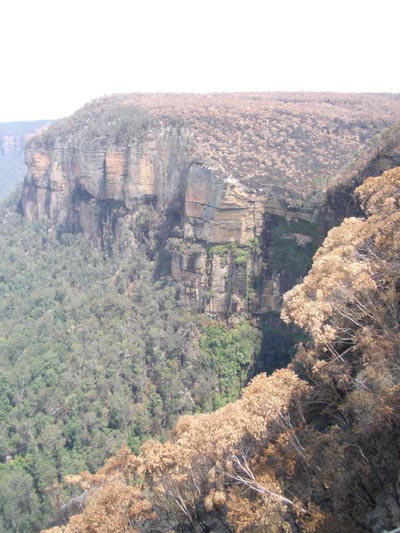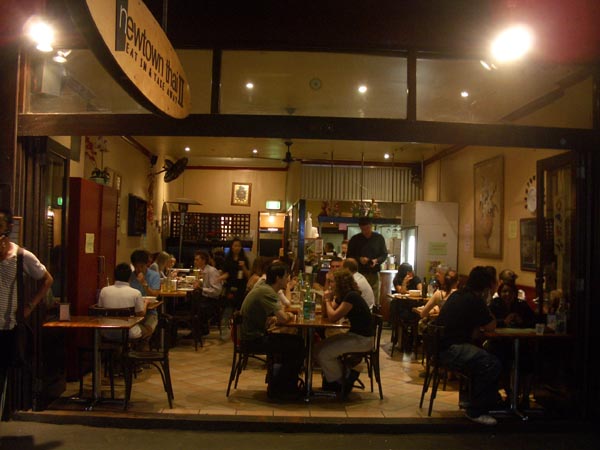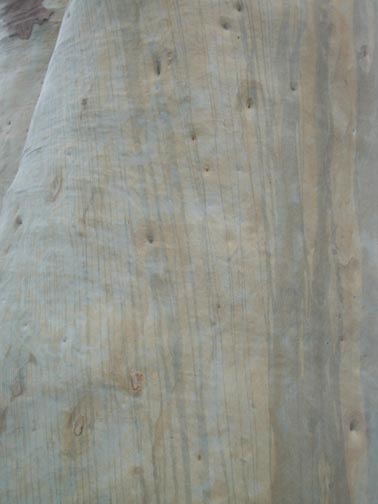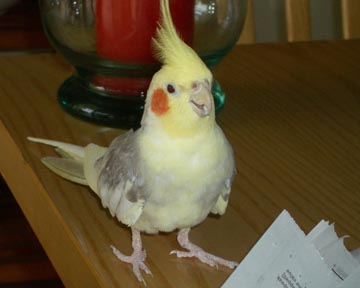
Return to home page
Go to my 2001-2 Australia travel book
Send a comment
Other blogs I'm reading: Christine Allen's // Gordon Price's
| December
31, 2006: -in the week after the first Christmas I spent in Australia, in 1982, I was amazed how the entire country closed down and went on holidays. It was hard to find a store open to buy milk or Vegemite, as everyone was at the beach. Much has changed since, as witnessed by the Boxing Day mobs scooping up bargains. But the country still takes a real break over New Year's: the post office, for example, shut down Thursday and won't reopen until Tuesday. And transit, everything from the trains to buses and ferries, has a "special holiday schedule," which means fewer/slower/more crowded. -we used to leave our Christmas tree up in Canada until 12th night. Here, a tradition is to leave it up until the Sydney Test starts on Jan. 2 (the test cricket, of course, which is series five of the aforementioned Ashes series against the Poms; the Poms have been humiliated, losing the first 4, but it doesn't mean they won't play it out to the bitter end; in the Melbourne Test, which began on Boxing Day and ran for 3 days, typical crowds were 90,000+, and the play goes from about midday until nearly sundown). -Just before going on his summer hols, the prime minister released a report recommending nuclear power generation for Australia. The country has about 40% of the world's uranium reserves, but has never had a reactor, instead producing most of its power from coal. With climate change being so much of an issue, the report talks about nuclear's advantages of being "clean and green," and suggests that the way to rationalize the higher cost of nuclear is by imposing a carbon tax, thus levelling the playing field, as it were. Commentators are noting cynically that it's a classic John Howard wedge issue, which he will play brilliantly: it's already showing signs of splitting the left into a doctrinaire anti-nuke camp and another, including some of the Greens, who think it has merit. But polls show that just 35% of Australians favour the construction of nuclear power plants; watch that number climb as Howard works his magic on the people. -another interesting bit of language: "black-armband" as an adjective, as in the former curator of the National Museum in Ken Bra, the nation's capital, who promoted "a left-wing, black-armband view of history." Translated, it means teaching history based around victims' narratives rather than the supposed great events of a nation. 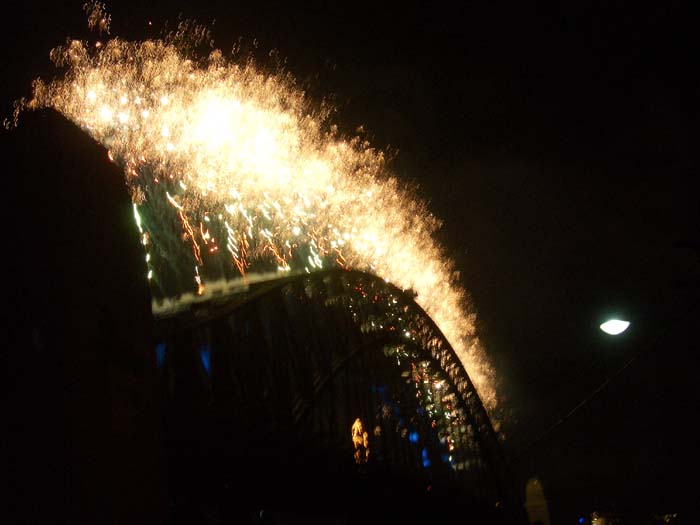 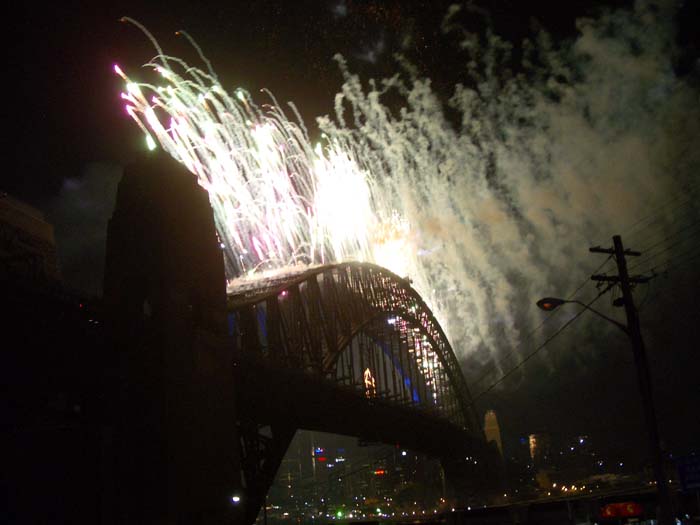 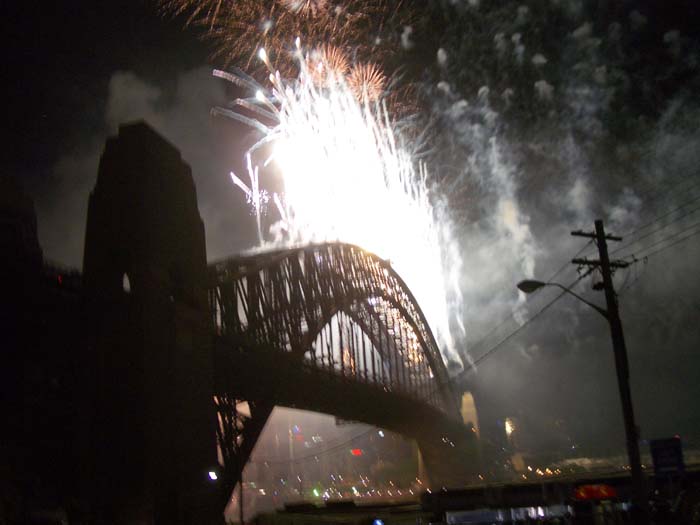 We spent New Year's Eve with a tableful of relatives and friends in an Indian restaurant about a half-hour walk from the harbour, then trudged down with the throng to see the fireworks, celebrating this year the 75th anniversary of Sydney's famous harbour bridge, nicknamed "the coathanger." The display from the bridge in these photos was bookended by identical, huge displays over the harbour above the Opera House on one side of the bridge and Darling Harbour on the other. There was much merry-making and general drunkeness, followed by a mad rush to the trains to get home. The threatened rain showers kept away, and it was a balmy 20-something for the 20-somethings who seemed to be the majority of the crowd. Estimates said that a million people watched the show; I always knew I was one in a million. Happy New Year! |
| December
28, 2006: - a note on the radio: cane toads arrived in Darwin. Huh? The march of the cane toads, which were first imported into Queensland to rid the sugar cane fields of a particular beetle, have spread now thousands of kilometres, destroying native species at every hop. They are particularly hard to get rid of as they are toxic, and thus avoided by the predators that are smart enough to avoid them. This environmental disaster was the subject of a hilarious Mark Lewis documentary, aptly entitled Cane Toads. And a Google search of "Cane Toads" of course brings up more information than could possibly be digested, even by the toads. -the best advice is to roar through yellow lights, especially if there's someone on your tail. If you should try to stop quickly, you'll likely collect the guy behind. But it isn't as dangerous as you might imagine, because traffic, especially cars turning in intersections, is very tightly controlled. In most city intersections, you can only turn right (the equivalent of a left turn in North America, right?) when you have a green arrow; similarly, you can only turn left when you have an arrow or a green light, depending on the intersection. So it seems safer, even though the traffic moves very fast and the lanes are very narrow. You can approach an intersection with a lot more confidence than in, say, Vancouver, where you're never sure whether someone's going to turn suddenly across your bow. -oh yes, and the use of hand-held mobile phones while driving is illegal. Again this is anecdotal, but people seem to pay a lot more attention while behind the wheel here. -received an apron for Christmas, entitled Dangerous Australians. Between a cartoon shark and a crocodile is the prime minister, identified only as John. Will this be a valuable collectable? Can he win a 4th term? -the share of the car industry of Australian-made cars has declined from 70% 20 years ago to about 20% today, according to a news report. The reason appears to be that Australian plants, especially Holden (the Australian branch of GM) and Toyota are making big cars that are mainly popular as exports. Toyota is making a bloated Camry, for example. Exported where? The Emirates were mentioned as one popular market. The cars and pickups (usually called utes) here are in general much smaller than North American ones, so that even a 4-wheel drive like a Toyota Land Cruiser seems immense on the narrow laneways. - I love the car park underneath the Franklin's supermarket in Katoomba. The ceiling is too low for vans or 4-wheel-drives, what the rest of the world calls SUVs. -News this morning: the Cross-city motorway tunnel, a public-private-partnership of the pre-Olympics run-up, has gone into receivership. High tolls, including a $3.50 one for the 2.1 km stretch under the CBD, are blamed. See http://www.abc.net.au/news/newsitems/200612/s1818730.htm |
December
27, 2006:
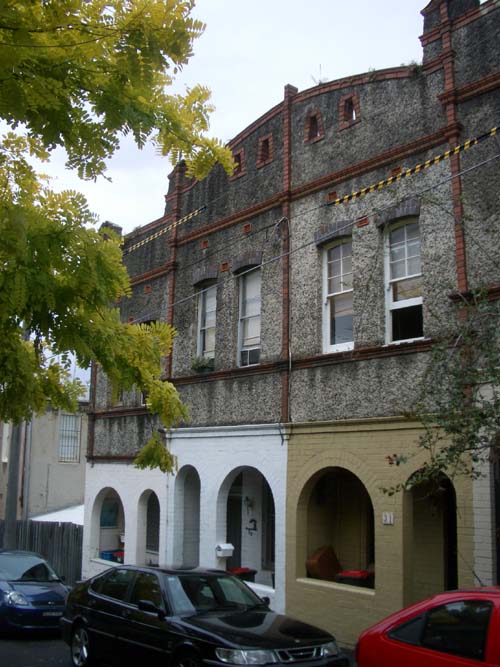 Notes about our Surry Hills terrace, aka Campsite 4 (the fourth temporary place we've occupied since leaving our farm in Langley in mid-August). We're at number 31 -- the beige one -- on Samuel Street, a single block narrow roadway in the Surry Hills neighbourhood immediately adjoining the south end of the Sydney CBD. The highrises of the city dominate the skyline from the top of the street. Surry Hills is the same vintage, more or less, as the much more famous Rocks district in the shadow of the Harbour Bridge near Circular Quay and the Opera House; like the Rocks, it was a slum for much of the 19th-20th centuries (although it didn't have the outbreaks of bubonic plague that made the Rocks so notorious), a backwater of poverty just as ripe as a December mango for urban renewal. Whereas the Rocks was largely restored and converted into a tourist area (like Gastown, e.g.), Surry Hills had random blocks demolished and replaced by a really ugly mix of brick and concrete buildings, some residential, others commercial or institutional. So it doesn't really work as a neighbourhood compared with most other old Sydney districts: shops like greengrocers and bakeries are all but non-existent, there are dozens of take-aways for by-the-slice pizza, lots of pubs and, along Oxford Street a few blocks away, the city's sleaze strip of fetish shops and other weird businesses thumps and gyrates (plus, it must be noted, the best discount art supply store in Sydney!). So if someone offers you a sublet or rental in Surry Hills and you want a nice middle-class vacation with walking access to Sydney's beautiful harbour, think twice! Streets like this one are a mix of fixed-up terraces and others awaiting the arrival of the fixer-uppers. Old hobo guys sit in some of the doorways on nearby streets and while away their days. Where they go at night is a mystery to me, but perhaps they doss down at charity hostels and run-down rooming houses nearby. (You don't see homeless people, or binners with shopping carts, like you do in Vancouver. There might be one or two truly homeless characters sleeping on the pavement near Central Station, a 10-minute walk away, but that's all you see in the entire city other than a few panhandlers, and there isn't the desperate poverty or obvious mental illness that we witnessed when we lived from August-November in the South Granville area at Campsite 1.) 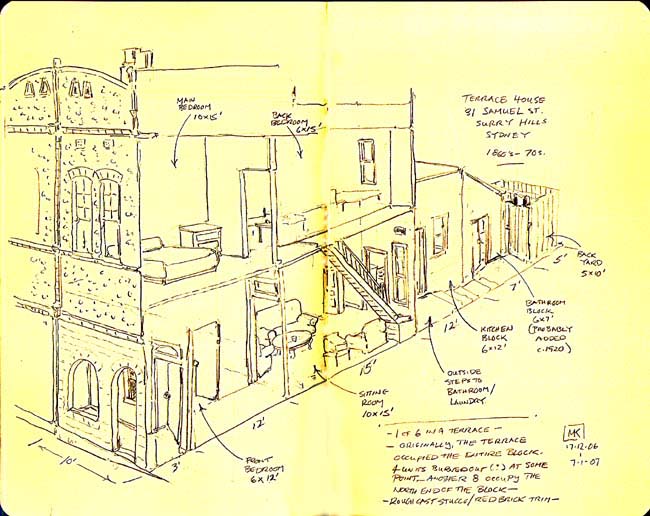 Ours is a pretty standard terrace, 10 feet wide by about 50 feet deep on the main floor, 30 feet deep on the 2nd. It's like Dickensian London in the sub-tropics. The idea of how working families lived, mostly Irish with mobs of children, the wife trying to cook over a coal fire in the summer heat, the dunny out the back next to the washing line, the children playing on the ten-metre wide street among the horse cobbles, husbands coming home totalled from the pub on Friday nights yadda yadda, is pretty hard to ignore as we enjoy the indoor plumbing, satellite internet and relatively clean air of 2006. A street like ours in Surry Hills was the setting of two 1940's Ruth Park novels, The Harp in the South and Poor Man's Orange, of Irish families struggling in the slums, which were made into television series. I read the latter about 15 years ago, and later saw its series. It was rather gritty, people trying to cope and people trying to get out, part of the genre in which Catherine Cookson stories fit. |
December
23, 2006: Rozelle market, 2 days till Christmas, and ....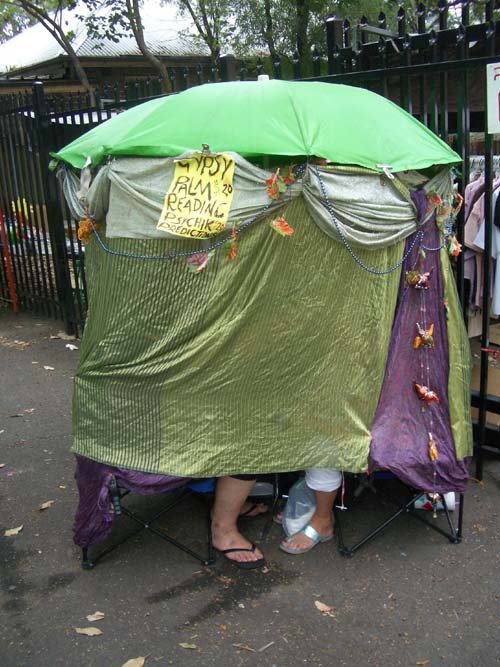 " ... I can see by this line that Santa's going to bring you everything you've asked for .... " Later that day: 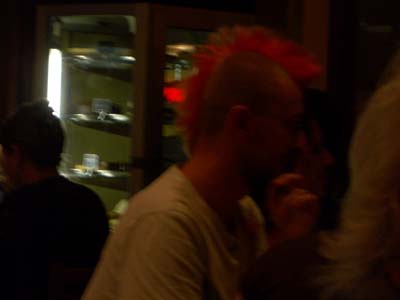 A "faux-hawk" in a Newtown restaurant. |
December
22, 2006: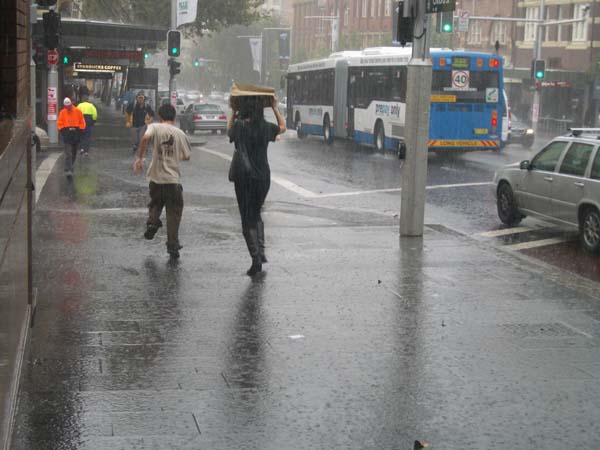 Rain on Oxford Street, Darlinghurst, the other day. It stopped after 15 minutes or so. -"A definition of a Sydneysider is someone who knows there are 8 "o"s in Wooloomooloo," says Sarah Jane. -The retirement of super-cricketer Shane Warne, known of course as "Woah-ney," led the newscasts, even on the comparatively intellectual ABC. Think the retirement of Gretzky. I think this level of interest could only accompany a cricket story, as opposed to a rugby or footie one, as in Canada only a hockey story would capture the imagination of the masses. Same legends involved, too: The Ashes series continues here (see Dec 12 entry); by comparison, how about Canada vs. Russia 1972? -Sarah Jane, our daughter, has lived in Australia for most of the past 13 or so years, but has retained most of her Canadian accent which, translated into Australian terms, is a sort of intellectual American one (not a "ha, y' all" one, e.g.). She teaches English to visiting international students, mainly doing graduate programs, at the University of Sydney and has found that her accent is an asset to her, as many of her students want to learn an "American-English" accent rather than an Aussie one. - Buses: charmingly slow, partly because the drivers still give change and a chat, so sometimes you sit at a stop forever. You can feel your beard growing while people are boarding. It has been commented upon that most of the transportation investment in Sydney since the Olympics build-up was in motorways. -Apropos of the motorwaysways, they are all tolled, as is the famous harbour bridge, opened in 1932 and tolled ever since (currently $3, payable only southbound). The best bet is to get an E-tag, which we are applying for. 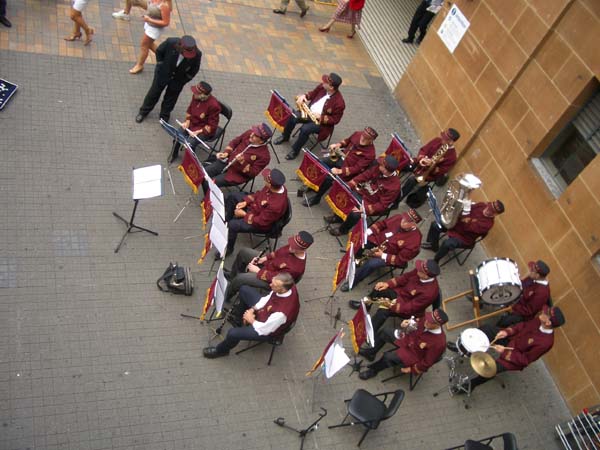 Not the Salvos' band, although they bear a passing resemblance. This is the NSW Railway band, taking a break between playing carols outside Central Station, Sydney. |
| December
21, 2006: "What
used to be cheap in Australia is now expensive, and what used to be
expensive is now cheap," Christine says. This after a couple of trips
to buy electronics and four weeks of buying food. Electronics are now
cheap due to one 5-letter word, C-H-I-N-A. But food has gone up a lot.
I used to think that the per-kilo price of something like meat or
cheese would be less than the per-pound price in Canada. Chickens, beef
and especially lamb were almost given away. Milk, cheese and butter are
still cheap, as are some seasonal fruits like mangoes. But vegetables
have gone up considerably, probably partly due to the drought. Meanwhile, Christmas goes on in its summertime way:  A tiny hipped-roof cottage in Leichhardt, burning electricity with seasonal abandon. Inner Sydney has few such displays, and this was the only house for blocks that had any lights on it at all. But apparently, once you get out into the western subs, lots of people have lights on their houses. The "westies," as they're called, are the butt of many jokes, a kind of suburban version of Trailer Park Boys. For example, if you drink VB (Victoria Bitter), a cheap beer like what Lucky Lager used to be in Vancouver, you might be branded a westie. Nearly the entire country will down tools this weekend and go on summer hols, with little reopening until some point after New Year's. But I'm unsure whether there are the mega-after Christmas sales -- whether the stores will be dumping their stock on Boxing Day [note from Dec. 26: the stores were so mobbed that one, Grace Brothers, had to close its doors and only allow in as many people as left]. |
| December
17, 2006: we
moved to a terrace house in Surry Hills, a very old suburb immediately
adjoining the City and just a 10-minute walk from Central Station ("the
City" is Sydney, aka Central Business District, what would elsewhere be
called downtown; all the suburbs, such as Surry Hills, Annandale and so
on, have their own elected councils). Surry Hills was a working class
area, all tiny brick row (called terrace) houses from the 1860s-70s.
Photos and a floorplan will be posted in a couple of days -- this is
really inner-city living. -Last week, on a visit into the City, I was struck by a major difference between Sydney and Vancouver (or, indeed, Seattle or the rest of North America): people don't walk along the street carrying coffee or even soft drink or water bottles. After 3 1/2 months in the South Granville area of Vancouver, I had come to the conclusion that the standard urban human/sheep walking style involved one hand extended slightly in front of the body, the fingers and thumb in cup-holder position (the other arm, bent at the elbow, positions a mobile phone near an ear, of course). In Sydney, nobody eats and drinks while they're walking. You see a lot of people buying take-away lunches and drinks from hole-in-the-wall delis, then carrying them to nearby parks or squares, but people don't amble down the street sipping from large cardboard coffee cups. Yes, there are Starbucks -- a few anyway in the City -- but the coffee culture in Sydney, which goes back to the milk bars of generations ago, is a sit-down-and-talk-with-friends one. Nevertheless, people here are as glued to their mobiles while they're walking as anywhere else.... -Coffees: traditionally, all the coffee in Aussie shops and restaurants is espresso, so you get the cappuccinos and lattes. But if you want a brewed coffee, the closest you can get is a long black (like an Americano); a long black with heated milk is called a flat white. -Interesting conversation last week with a man whose wife's 10-year-old Toyota Corolla we wanted to buy. They had decided, apropos of climate change, to sell it and his car, an Audi, and buy a Toyoto Prius hybrid (pronounced Pr-eye-us here, as Adidas is pronounced Aw-dee-dahs and Nike is pronounced nike, i.e. without the final "ee", but anyway, revenons à nos moutons). We liked the car but dithered and got gazumped: i.e. he sold it to someone else. We instead found a 2001 Echo hatchback, which is as economical and environmentally friendly as we can get. -And further to climate change, there's an on-line pledge form, at http://competitions.f2.com.au/enter.cgi?competition=earth_hour, sponsored by the WWF, supporting the campaign to turn off the all the lights in Greater Sydney for an hour on the evening of March 31. It got a lot of press in Sydney and hopefully will spread to cities around the world: will someone start it in Vancouver? You sense a slightly optimistic shift in people here, partly because Labour has chosen a new leader, Kevin Rudd, to contest the next election against the entrenched, anti-Kyoto Howard government. Rudd is quite green and determined to change Australia's environmental policies (except on the news tonight, he reversed Labour's policy on preserving Tasmanian old-growth forests, admitting that the previous policy had cost Labour the state in the last general election -- so much for greeness). Interesting, also, that he makes no secret of his strongly held Christian beliefs -- almost like the old CCFers in Canada, like Woodsworth and Douglas. In Canada now it's the right who profess religious values, here it looks like it's going to be the left. -Amazing how much writing you can get done on the 2-hour train ride up to the Blue Mountains! A rumour about the voters in Katoomba, the largest of the Blue Mountains towns and the one where we're likely to move next: half vote Green, the other half for the ultra right wing and nationalist Pauline Hanson and her One Nation party. |
| December
11, 2006: my brother-in-law, Doug Coulson, added greatly
to my understanding of Australian society when he demonstrated that the
Australian national anthem, "Advance Australia Fair," could be
successfully sung to the tune of Gilligan's Island. Try it! Australians all let us rejoice For we are young and free We've golden soil and wealth for toil, Our home is girt by sea: Our land abounds in nature's gifts Of beauty rich and rare, In history's page let every stage Advance Australia fair, In joyful strains then let us sing Advance Australia fair. Beneath our radiant Southern Cross, We'll toil with hearts and hands, To make this Commonwealth of ours Renowned of all the lands, For those who've come across the seas We've boundless plains to share, With courage let us all combine To advance Australia fair. In joyful strains then let us sing, Advance Australia fair. (Of further
interest, he noted that the lyrics of the New Zealand national anthem
fitted perfectly into "Twinkle Twinkle Little Star.")
To hear the proper melody, go to http://www.imagesaustralia.com/australiannationalanthem.htm |
December
8, 2006: 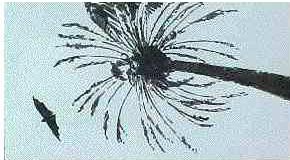 Everybody in Vancouver knows about the thousands of crows that fly from the west side out to Burnaby at dusk every day. In northern Sydney, it's fruit bats aka flying foxes that leave the city by the thousands and fly northward every evening to roosts near Hornsby. (Above: a sketch from 2001 of fruit bat and palm tree, which was going to be, and may be one day, a woodcut). Note to Stephanie about language: You'd find that a lot of Australianisms are common to lower-class Brits -- e.g. prat. And the same for spellings -- almost no z's, e.g. in realise. Thus, it is surprising the disdain Australians feel for the poms, particularly during the multi-week cricket series called the Ashes, which is going on now and dominating most conversations. |
Send
a comment From Stephanie Gould: This slang is almost completely unfamiliar to me (no doubt we have an equivalent here?), except that it brings back memories of an Aussie landlord we had in Vancouver in the late 1970s. He lived in an apartment above us and had a competition going with one of his friends to see who could seduce the most women in a single day. He spent a lot of time in his bathing suit. Being about 18 or 19 at the time and married, I didn't feel inclined get to know him very well, but I remember his speech was full of words like prat. |
December
4, 2006: 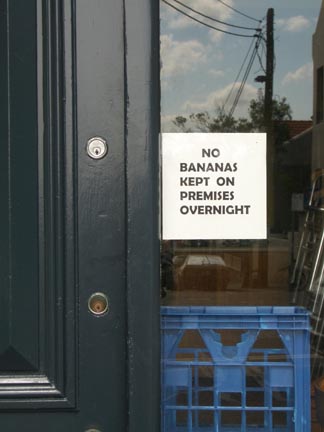 A shop near the Rocks in Sydney. The reference is to the acute banana shortage caused by a recent cyclone that tore through Queensland. |
Send a comment
Return to home page
